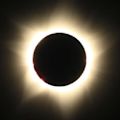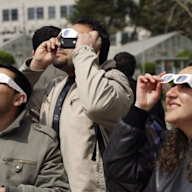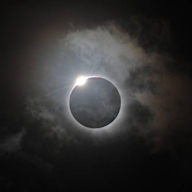Search results
People also ask
What is a total solar eclipse?
What happens during a total solar eclipse?
What is an example of a total solar eclipse?
How does a solar eclipse occur?
What is a partial solar eclipse?
What is a solar eclipse season?
A solar eclipse occurs when the Moon passes between Earth and the Sun, thereby obscuring the view of the Sun from a small part of Earth, totally or partially.
Apr 8, 2024 · A solar eclipse occurs when the moon orients itself between Earth and the sun, shielding the solar surface from our view. In cosmic terms, it is unusual that this happens: the...
- Katrina Miller
- 2 min
- The Moon Eclipses The Sun
- Types of Solar Eclipses
- Solar Eclipses Mainly Look Partial
- Only Around New Moon
- Protect Your Eyes!
- GeneratedCaptionsTabForHeroSec
An eclipse of the Sun happens when the New Moon moves between the Sun and Earth, blocking out the Sun's rays and casting a shadowon parts of Earth. The Moon's shadow is not big enough to engulf the entire planet, so the shadow is always limited to a certain area (see map illustrations below). This area changes during the course of the eclipse becau...
There are 4 different types of solar eclipses. How much of the Sun's disk is eclipsed, the eclipse magnitude, depends on which part of the Moon's shadowfalls on Earth. 1. Partial solar eclipses occur when the Moon only partially obscures the Sun's disk and casts only its penumbraon Earth. 2. Annular solar eclipses take place when the Moon's disk is...
Solar eclipses are only visible from within the area on Earth where the Moon's shadow falls, and the closer you are to the center of the shadow's path, the bigger the eclipselooks. Solar eclipses are usually named for their darkest, or maximum, point. The exception is the hybrid eclipse. The darkest point of solar eclipses is only visible from a sm...
For a solar eclipse to take place, the Sun, the Moon, and Earth must be aligned in a perfect or near perfect straight line. A rough alignment of the three bodies happens every lunar month, at the New Moon. So, why isn't there a solar eclipse every New Moon? The plane of the Moon's path around the Earth is inclined at an angle of approximately 5° to...
Never look directly at the Sun, eclipsed or otherwise, without any protective eyewear. The Sun’s radiation can burn the retinas in your eyes leading to permanent damage or even blindness. The best way to safely watch a total solar eclipse is to wear protective eclipse glasses or to project an image of the eclipsed Sun using a pinhole projector. Top...
Learn what a solar eclipse is, how it happens, and what types of solar eclipses exist. Find out when and where the next solar eclipses will occur and how to safely observe them.
Apr 8, 2024 · A total solar eclipse — nicknamed the Great North American Eclipse for its long path over North America — was visible in the sky today over parts of Mexico, 15 U.S. states and eastern Canada.
Apr 7, 2024 · What is a total solar eclipse? A total solar eclipse occurs when the moon passes between Earth and the sun, completely blocking the sun’s face. Those within the path of totality will see a...
- 1 min
Apr 8, 2024 · On April 8, 2024, a total solar eclipse moved across North America, passing over Mexico, the United States, and Canada. A total solar eclipse happens when the Moon passes between the Sun and Earth, completely blocking the face of the Sun. The sky will darken as if it were dawn or dusk.
Mar 18, 2024 · Learn about the science behind solar eclipses, how to watch safely, and how to engage in scientific observations and discovery with NASA. Find out when and where to see the total solar eclipse on April 8, 2024, and explore interactive maps and lessons.






